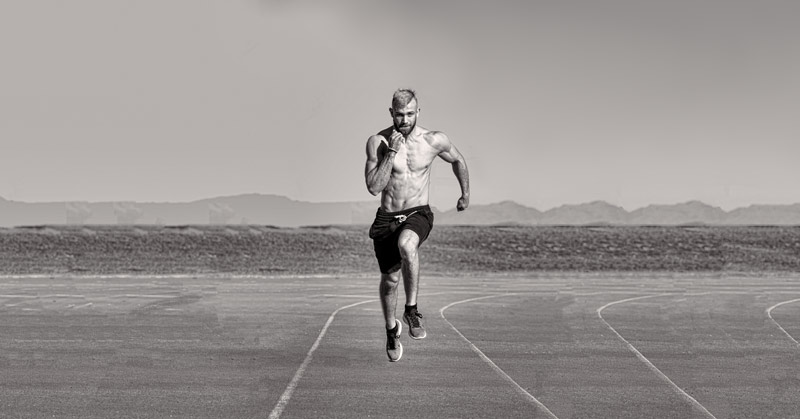
By Carl Valle
My previous article on the five best cues in developing maximal velocity stressed the limitations of conscious effort to distal parts of the body, and how feedback must be carefully done. This article shifts the focus to physical capacities and training concepts to improve the ability to run fast. It breaks down lessons I learned from coaches with a knack for getting people on the podium. Team sport athletes will also find these concepts helpful, as upright running is a fundamental need for most athletic endeavors. When I started coaching, I thought improving maximal velocity automatically happened by just doing a few fly sprints. The truth is that reaching maximal velocity is very stubborn and highly genetic, so development must be carefully orchestrated.

Rhythm Development
After writing an article on rhythm, I felt it necessary to revisit the quality, specifically about its relationship with maximal speed. The importance of prime mover rise times (rate of force production with propulsive muscle groups) and rapid silence periods (rate of muscle shutdown) is paramount for top speed, and sprinting improves when contractions become more uniform.
Watching and videoing practices of talented coaches revealed the tuning effect of those masters. They were very focused on their athletes’ times, but how they conducted their practices was just as important. The best solution is not choosing one of these options but doing both—not an easy task. Athletes given constant feedback regarding their speed with objective measurement can have very fine runs that maintain rhythm and ensure that every rep is good, not just “popping” a good one and going home.
Coaches Point: 150m runs or 30m flys are more effective by running through them with the same velocity after acceleration is completed. Even splits prevent deep fatigue and save more absolute work for later. Rhythm is about maintaining a constant rate, and controlling speed does work. Build speed up in addition to including rhythm, and see how long you can hold that velocity.

Sprinting While Fresh
Perhaps the most obvious need in quality work is patience and being confident in doing less, so athletes don’t perform speed work while fatigued. Technically speaking, no sprinter will ever be 100% fresh, and that is okay. Nobody wants to be flat, but the training between heavy and hard speed work should be enough to maintain qualities not supposed to be priorities and sometimes improve other qualities over time.
Sometimes you can’t do speed work with as much frequency as online workout templates claim. Forty-eight hours may restore the nervous system after a speed workout, but it’s never complete and other elements of the body (such as tendons) are slow regenerators. I have said countless times that improvement is about the amount of quality training during the year, not about one great week. Be conservative while slowly and incrementally increasing workloads. Every year I learn how to estimate training load more accurately given the data though team sports will always be struggling due to the complexity of the variables they have.
A lot of training programs exist. Quality-based programs require extreme precision while volume programs are about staying healthy. I like enough volume to poke the fire of adaptation to neurological stress and doing just enough speed to improve firing rates. It’s not exciting but putting all my eggs into one variable is too much of a risk.
Coaches Point: I have learned from some coaches that the three days before and after a speed session can make or break improvement. It takes a lot of confidence to rest and to do lighter workouts. I suggest mirroring the training, so no one goes back too hard too early and does the speed session in the middle of the week to remove residual fatigue.

Running Coordination
Many successful programs focus on running. That is, most of the training volume and session times cater to quality running, not sprinting. Many coaches in team sports are frightened when they see the amount of “jogging” in running-based programs and wonder where the speed work is. Keep in mind the length of the season of a professional sprinter and gradual development is fine. I will get to the point of racing and adaptation later, but preparing specifically leads to overuse syndromes and burnout. Much of fall training is fitness-oriented. While this may seem more a distraction set of exercises, it works because the progression is slow.
Talent may be enough to be a good sprinter, but to be a great sprinter you must be skilled. Many look at tempo running as a way to recover faster. During deep training, it may help, but as one is closer to ideal form it may interfere. I have been beaten plenty of times by people who did less weight training and plyometrics, and the reason was clear. The fastest sprinters are great runners. Running may be a different beast than sprinting, but they are still similar animals and being a great runner still matters.
The age-old questions are how much, when, and how fast. I don’t have an answer, but I do have a point of reference. Athletes who don’t look good while running will most likely exhibit errors when they sprint. The key is not looking at what visual qualities overlap specifically. Most kinematic measurements are related to effort and power, not replicating motions. Arm action and knee lift are really not technique issues. Most of it is speed or joint function issues. When athletes are running smoothly, they have a better chance of success. But like most things in life, no guarantees exist. Some athletes look like DVD All-Stars with drill technique or running, and fall apart in fast speed work. That stuff happens. Running is very innate, and our job is to be sculptors and reveal it.
Coaches Point: Increase the amount of running, and sprint only when ready. Running volume is based on the athlete, not the training plan. Each athlete can tolerate different volumes, and that is normal and expected. Simply look at the yearly volumes and increase more slowly than what looks good on a chart. For 1% increases in speed, we don’t need 20% bumps in volume. Make sure your athletes are competent runners so they can be great sprinters.

Elastic Power
Elastic power becomes more important than maximal strength as speed increases. The types and amounts of elastic work are always a little bit of an experiment. Clear progressions are available, and it is important to know how to measure effectively elastic power in jumping and what small transfer opportunities exist.
As we all know, jump training and/or plyometrics come with risk. It’s better to miss out on maximal or absolute benefits and address elasticity with a solid program, rather than trying to be a maestro and have things backfire. Also, tendons degenerate at different rates, and some athletes are more genetically prone to having collagen not remodel as well. Running fast doesn’t require jumping at all so be cautious. One other factor is the need for optimal levels of vitamin D. Otherwise the risk of tears to joints increases.
I have written numerous articles about plyometrics and measuring jump training. The key is not having a weakness and letting athletes blossom. But don’t force anything. When athletes are not responding to training and not improving, it’s either coaching or a dysfunction/injury. Learn to walk away with the chips on the table and not get greedy. It feels good to see the numbers improve, but at the end of the day the clock matters more than the tape measure.
After exchanges with better and more accomplished coaches, I have developed three categories of athletes: fragile, average workhorse, and resilient thoroughbred. In addition, I have identified four small stages of development. First is the awareness and exposure level for neophytes. Second is the foundational level of competence in the exercises. Third is the development or capacity type, a level that most can achieve. Fourth is the exploitation level that transfers plyometrics further than just a stimulation-type option. Each level increases risk, so everyone should be able to do the movements injury-free. Only progress to the next level when it makes sense to do so.
Coaches Point: Use plyometrics or jump training to reduce injuries and increase durability, then progress them to get an actual transfer. Every athlete is unique and every season is different with the same athlete. Do enough to be competent and learn to focus on the running and sprinting side. Do not push jumping limits too much or it is likely to backfire. Jumping is also great for tracking and managing power, so do enough to peak into the body when maximal speed work is not an option.

Meet Selection
I believe meet selection is more important than coaching for most emerging elites. It’s far easier and more common to ruin a good season with the wrong competition than not having access to great coaching. Plenty of great coaches are available, but meets can be difficult to select unless one is a world-class podium finisher. The wrong meets with the wrong competition ruin many seasons.
Some methods of selecting meets and philosophies are hard to test for validity, but meets need to provide more than just a fast surface. If the travel and timing of the meet aren’t appropriate, athletes have withdrawn from their bank accounts and missed time better spent in either training more or going to a better option. Here are some factors to consider.
When to open up? Coaches and athletes must work on a benchmark in training that projects the value of competing beyond curiosity. Not one indicator is there, but some coaches have a system when they know it’ s worth going out there.
How to open up? Does the athlete go for it and truly compete, or simply get a performance out of the way to shake things free? I am not a fan of “just go out to see what happens.” While the feeling of getting a race may sometimes be comforting, not caring about the outcome rarely helps. But it’s okay to get a meet under one’s belt to start a season if necessary. Running with nothing to lose is okay, as it’s good to experience the natural joy of sprinting without expecting something in return.
How many races? Not only does the total amount of races matter, how they are distributed is important as well. I have learned that it’s better to select meets based on when one is ready and pick times to get more training in. Each athlete is different, and some need a lot of training to race while others just use races to keep sharp and improve. It’s largely a matter of listening to the athlete and knowing when it’s time to be competitive.
Coaches Point: Athletes and coaches must pick meets that matter and have enough to peak during the season. Sometimes it makes sense to open later, start training later, or even open up early. Competition is great training for those who need arousal to sprint fast, and racing schedules should be based on training and mental readiness. While confidence comes from self-belief, it’s increased from good training. So it’s important to pick meets that athletes feel like they can do well in.
Putting it all together and Planning
It’s not a mystery that maximal speed is trainable but requires a lot of attention to planning. In deciding on what needs work first, I start with testing and look at training history. Some athletes are wide open to improving in some areas, and some concepts are maxed out or have been overly focused on. Some coaches have injured athletes because they felt comfortable with one area. I learned early that diversifying stress is the best way to reduce unnecessary risk.
Reduce competition or team practices. High-volume programs are never a problem if they are working. However, many programs operate on junk reps or junk volume. Junk volume can be anything that doesn’t make an athlete better. The problem is that most programs doing junk work are not aware of what they are doing. Years ago in Boston, I sat down with Mladen Jovanovic. He used the term “stupid fatigue”: getting tired but not improving. We also see that a lot with circuit training.
Decide if your jump training is working and worth the effort. Plyometrics either help or harm. Period. The margin of error for plyometrics is so small that it’s more likely one is going to feel the effects of tendon problems down the road than getting better from them. A good overall plan is to address plyometrics, but don’t push them unless you are a jumping athlete. While adding plyometrics helps, thinking they are the missing link may be dangerous. Also, the goal of any rehabilitation program is doing the training that got you there in the first place. If athletes can’t replicate activities they did in the past, you need to rethink if the therapy was successful. Injustice (inability to perform an exercise from the past) somewhere means injustice everywhere later. Finally, don’t fight something. It may mean that someone is damaged goods, and it’s better to move on if you have exhausted all resources for improvement.
Manage fatigue but don’t avoid it. Everyone in sports science is afraid of fatigue. Ignorance is bliss sometimes, and negative attention to anything—be it injury or fatigue—is a bad idea. At times when one is not competing or practicing intensely, heavy training and residual fatigue are normal and necessary. Being fresh is important when doing quality work. But to do quality work one needs to build up, and that may not mean doing quality work all the time. Too many times I see efforts to feel fresh, and one needs to be fresh during near maximal performance days.
Developing maximal velocity from training is not just limited to the ideas above. It’s about using what has worked in the past and adding a few more details that polish speed. Everything has to be right when athletes hit a genetic ceiling, so it’s never overzealous to pay attention to detail. Even a .01 improvement in a flying 10m can help someone go from finalist to winner.
Please share this article so others may benefit.
[mashshare]

